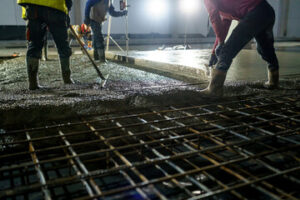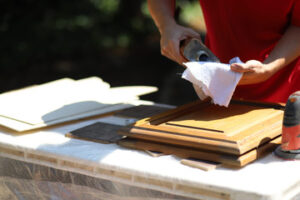Concrete Contractors turn construction plans and specifications into concrete reality through their expertise and craftsmanship. They work tirelessly to deliver quality and satisfaction on projects of all sizes and scopes.

They have a strong passion for their craft and are dedicated to the continuous improvement of their skillsets. They also follow safety protocols to ensure a safe working environment for themselves and their crew members.
Working with concrete requires a high level of skill and attention to detail. This is why it is important to choose a professional contractor with the right experience and expertise to ensure that your project will be done correctly. Choosing the wrong contractor can lead to costly mistakes, delays, and a finished product that does not meet your expectations. In addition to being properly licensed and insured, a good concrete contractor should have a reputation for ethical business practices and a commitment to customer satisfaction. You can also ask for references from previous clients and check online reviews to get an idea of the contractor’s reliability.
Concrete contractors specialize in transforming raw construction materials into long-lasting and durable structures that can withstand the elements. Their work involves a thorough examination of blueprints, meticulous determination of the required materials, and careful assessment of environmental considerations. Professional concrete contractors adhere to strict building codes and regulations, preventing legal issues and ensuring the quality of their work.
A professional concrete contractor will also have access to a range of specialized tools that are not available for DIY projects. This will allow them to complete the job faster and more efficiently, while delivering superior results. They will also know how to use the equipment properly, reducing costs by minimizing waste.
In addition to specialized tools, concrete contractors should have the necessary equipment for large projects such as driveways and patios. This will save you the cost of renting or purchasing expensive equipment for a single project, and ensure that the job is done right the first time.
Reliability
Reliability is a vital trait for any contractor, but it’s especially important in concrete work. A reliable concrete contractor is one who will deliver high-quality results and complete the project on time and within budget. It’s also a good idea to look for a contractor with relevant experience and expertise in the type of concrete project you’re planning. You can find this information by checking their website or asking for referrals.
Another quality to look for in a concrete contractor is their commitment to excellence. This is evident in the way they work and in their communication with clients. A reputable contractor will adhere to industry standards and will use the latest construction methods to ensure that your concrete project is durable and long-lasting.
You can also determine a contractor’s reliability by looking at their past projects. Reviewing case studies will help you learn about a contractor’s approach to different types of commercial concrete projects. It will also give you a sense of their problem-solving skills and resilience. Look for case studies that showcase successful concrete projects.
A reputable concrete contractor will provide you with a warranty on their work. This will protect you from any issues that may arise after the project is finished. In addition, a warranty will show that the contractor is confident in their work and is willing to stand behind it.
Local concrete contractors are also a great choice because they understand the unique characteristics of our area’s climate and know how to build structures that will stand up to the elements. They’re also more likely to be available when you have questions or need to sort out an issue mid-project.
Experience
Professional concrete contractors have extensive experience working with a variety of different construction materials, including different types of cement. Their expertise ensures that your project is completed properly and quickly. They also know how to deal with issues that may arise during a project, minimizing costs and preventing delays. Inquire about their previous projects and ask for references to determine if they are a good fit for your project.
Inquire about the contractor’s licensing and insurance coverage. This will help you avoid unauthorized and unqualified contractors. You should only hire a contractor with a valid license that indicates they meet industry standards and have liability and workers’ compensation insurance.
A professional concrete contractor understands that every project has unique challenges and will work with you to address them. They will use their extensive knowledge of concrete materials, dry times, and structural support to provide quality results. They will also have the right equipment to efficiently complete your project and minimize labor costs.
Ask the contractor to show you a portfolio of their previous concrete projects. This will help you assess their workmanship and see if it aligns with your vision. You should also ask about their safety practices and their commitment to maintaining a safe work environment.
It is important to choose a contractor who is passionate about their work. Those who are truly dedicated to their craft take pride in their craftsmanship and are eager to solve problems and deliver high-quality results. They are always learning and improving their skills, which helps them maintain a competitive advantage in the market. This passion translates to superior results and a solid reputation in the industry.
Locality
Whether it is for sidewalks or driveways, patios, or foundations, concrete work plays a pivotal role in construction projects. Specialized contractors working with this material ensure that construction is carried out safely and correctly. Choosing the right contractor ensures that your project is completed on time and within budget. In addition, it is crucial to find a commercial concrete contractor with experience and expertise in the type of project you are undertaking.
Before a project begins, a reputable concrete contractor will meticulously plan the details and requirements. This will include assessing the scope and evaluating any potential risks and issues that may arise during or after completion of the project. A contractor with a passion for their craft and commitment to the industry is more likely to excel in their work.
Contractors with the proper certifications are able to navigate local building codes and environmental considerations, streamlining the approval process for your project. This helps avoid costly delays and provides peace of mind. It is also important to find out if your contractor is insured and bonded, as this will protect you from financial liabilities should an accident or other incident occur during the course of the project.
The type of concrete finish work that a contractor specializes in differs by specialty, so it is important to ask them what kind of work they do best. Moreover, you should also ask whether they offer warranties on their work, which are enforceable under certain conditions. This way, you will be able to get your concrete structure repaired or replaced should it become damaged.
Free Estimates
Professional contractors offer free estimates of the cost of their services. This is an excellent way to ensure that you are getting the best value for your money. The estimate will also give you a clear idea of how long the project is likely to take. This will help you plan ahead and avoid any surprises. During the estimate, ask the contractor if they can accommodate any customization requests that you may have.
It is important to choose a concrete contractor that has extensive experience. An experienced contractor will be more familiar with various challenges that may arise during the project and be able to tackle them effectively. They will also know how to work with architects, engineers, and other construction professionals to ensure that the concrete work complies with local regulations.
Concrete contractors are experts in their field and use this expertise to create quality results that will last for years. They can also advise you on the best ways to achieve a particular style or finish, saving you time and money. Concrete contractors often provide a variety of finishing options for their concrete work, including stains and coloring, surface textures, and decorative elements.
When choosing a concrete contractor, seek recommendations from friends and family members who have used their services. You should also look for online reviews and ratings. These sites can help you find a reputable Concrete Contractors that will meet your needs. Make sure that the contractor is licensed and insured to protect yourself against any damage during the project. It is also important to understand their pricing structure and whether they charge extra for additional services. If you are looking for a residential concrete contractor, check out their website for testimonials and pictures of past projects.








